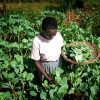Wednesday, May 15, 2024
News and Views from the Global South
The Solutions to Child Poverty Must Reach the Most Vulnerable Communities

Credit: UNICEF / Oleg-Popov
- Child poverty persists even in some of the world’s richest countries, new findings from a UNICEF report reveal.
UNICEF’s Office of Global Insight and Policy’s latest report details the prevalence of child poverty in 39 EU and OECD countries. It reveals the extent of child poverty in these countries and how these cases vary from middle-to-high-income countries. Titled Child Poverty in the Midst of Wealth, this report is the latest in the Innocenti Report Card series, which observes children’s well-being in high-income countries. Within these countries, over 69 million children were living in households earning less than 60 percent of the average national income level. Across these countries, there was a reported 8 percent decrease in poverty levels between 2014 and 2021. During this period of relative prosperity, countries took this as an opportunity to address child poverty, with varying levels of success.
Of the countries assessed for this report, Slovenia, Poland, Finland, and Denmark reported child poverty reduction rates that exceeded 30 percent. By contrast, higher-income countries such as the United Kingdom, the United States, Australia, and France reported a high percentage of child poverty and even saw these rates increase in recent years.
Determined by assessing and comparing child poverty rates through two metrics, the first was to compare the national income level and child poverty levels in the 39 countries. It was found that although the richer countries had higher national income levels, they did not have lower child poverty rates. This meant that a higher national income did not guarantee these countries’ ability to reduce child poverty. It only makes the contrast more striking when compared to countries such as Slovenia and Poland, which are not ranked among the wealthiest countries.
The second metric used to measure child poverty was what the report referred to as ‘non-monetary poverty’. This was determined through needs assessments where a person could not access certain services or through seeking the opinions of those living through poverty. Poverty was measured through material deprivation, the absence or lack of services and goods, or housing security.

Credit: UNICEF / Alexandru-Saru
Multiple factors could contribute to the high poverty risks in these countries. Poverty itself should be assessed from a multidimensional perspective. The report notes that since 2020, global events such as the COVID-19 pandemic, the war in Ukraine, and disruptions in the global supply chain have upended our way of life. These global events left already-vulnerable communities, including children, at greater risk of living in poverty. Economic relief programs that were either introduced or expanded on during the early pandemic era are at risk of not being renewed or beyond their capacity to support the families that need them. The rise in living costs, from food to energy to housing, has put more pressure on low-to-middle-income families. For single-income families and particularly single-parent households, this poses a greater challenge if they live in high-income countries and if these families’ incomes are largely spent on these living costs.
It was observed that children experiencing persistent poverty, in that they have lived in poverty multiple times in their lives, are more likely to exhibit behavioral and learning difficulties. In the long term, they do not complete schooling or earn lower wages as adults.
The report also notes that certain inequalities present greater poverty risks. Children living in single-parent or one-adult households are at least three times more likely to experience poverty. It was also noted that children from minority communities were more likely to live in income poverty. These communities included racial and ethnic minorities, children whose families had migrated to their host country, indigenous and Roma children, and children with disabilities. In the EU, for instance, 37.2 percent of children whose parents were migrants lived in income poverty. This contrasts with the 15.6 percent of children whose parents were citizens of the country.

Credit: UNICEF / Ashley-Gilbertson
Among some groups, the higher risk of poverty is only one indication of the systematic disadvantages that they face, according to Gwyther Rees, Social and Economic Policy Manager at UNICEF Innocenti. Rees, who is one of the authors of the report, told IPS that the groups that need social protection are often not accessing them, in what is referred to as “non-take-up.”.
“Non-take-up of social protection affects all groups, but paradoxically, it is most prevalent among the most marginalized and, therefore, most in need of social protection,” he said. “There are multiple reasons for this, including, for example, a lack of financial inclusion (such as having a bank account), stigmatization, which discourages certain groups from accessing social protection benefits, and complex application procedures and hurdles, to name a few.”
Based on this report, it is clear that comprehensive changes need to be made in how countries tackle poverty reduction. The report recommends the broad measures that countries should take, including expanding social protections for children, improving access to essential services beyond financial support, expanding labor policies to ensure decent pay and working conditions for parents, and mitigating the inequalities in poverty risks. For children in minority groups, this will require ongoing action to make sure the barriers that prevent them from accessing these social protections are dealt with.
One noteworthy conclusion of the report is that children should be included in the discussion of poverty reduction. Children with lived experience would possess their own insights and perspectives. Just as children and adolescents have been proactive in environmental activism, there is hope that they will be encouraged to act similarly on the issue of poverty reduction. Rees told IPS that UNICEF Innocenti has been conducting consultations with children on their views on poverty in six countries, with plans to share their findings in 2024.
IPS UN Bureau

 Print
Print



